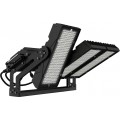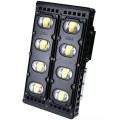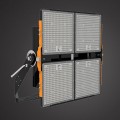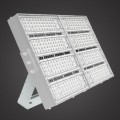Eastar Lighting unveiled an energy-efficient LED lighting system designed to offer an unmatched level of light control and precision. In the past, when architectural lighting designers were confronted with the task of uniformly illuminating the playing surface of a sports field while cutting down the energy consumption by the high power luminaires. Conventional sports lighting system consumes a considerable amount of electricity to generate illumination from each fixture. Stadiums generally light the field for at least 250 foot candles at any point on the playing filed. To obtain this level of illumination with metal halide (also referred to as high intensity discharge, or HID) lamps will consume approximately one megawatt of electrical power for the field alone. While metal halide lamps are still prevalent, they are not without drawbacks. One problem with metal halide lamps is bulb life. The 1,500 watt metal halide lamps frequently found in stadium fixtures, generally have bulb operational life in 3,000 hour range. The initial start-up process typically take 5 to 7 minutes and hot restrike process can take as long as 20 minutes. The TGC series LED stadium lights are developed to address above concerns and bring with added benefits. Light emitting diodes (LEDs) offer many advantages over HID light sources, including: lower energy consumption, extended life span, improved robustness, scaled-down size, instant switching, and excellent durability and reliability. The state of the art high power LED luminaires significantly alleviate sports lighting designer's concerns to balance a number of factors, for example, light quality, energy consumption, durability, longevity, and maintenance cost, to name a few, in stadium lighting.

As a byproduct of converting electricity into light, however, high power LEDs generate a massive amount of heat that can raise the operating temperature if allowed to accumulate, ultimately causing efficiency degradation and premature failure. Needless to say, this is undesirable since shorting the LED's life would lose one of its primary benefits of using this type of light source. Hence, an advanced thermal management technology is incorporated into the lighting system to remove to redistribute heat from high power LEDs through effective thermal conduction with these heat sources. 12xΦ8mm heat pipes are riveted directly under the light source substrate to transfer the heat away from heat sources the based on principles of a thermal conductivity and phase transition heat transfer mechanism. The heat pipes are made of high purity copper which have a very high thermal conductivity of up to 400 W/m-K or more. They provides thermal conduction pathways through which the heat is drawn away from the LEDs and delivered to an integrated heat sinking system that provides thermal management, mechanical support, and optical positioning and control. The heat sinking system is comprised of a plurality of heat dissipating fins to provide enough surface area to effectively radiate heat to the ambient atmosphere. The fins are integrally engaged with each other to provide a strengthened structure support as well as to further improve the heat circulation performance. The cooling fins are flushed with the luminaire base plate, minimizing the heat transfer resistance.
The TGC series LED stadium lights feature an excellent optical performance which is an important part of sports lighting systems. The CREE XT-E white LEDs are optimized for directional, high-lumen applications, provide a guaranteed minimum efficacy of 125 LPW at 85°C, 350mA. Combined with the anodized and polished aluminum reflectors, the luminaire provide precision narrow beams and contributes to a reduction in spill light, without generating obtrusive light. The increased efficiency combined with the increased intensity of narrow beams enables not only adequate illumination of distant part of the playing area, but also crossing of luminaire aimings in order that lights from different luminaires can blend. The new lighting system provide previously unparalleled efficiencies for energy usage, uniformities for separate parts of the playing field, and high percentages for the modeled area with respect to the playing area. This will help in improving visibility for players and also spectators while boosting the quality of television broadcasts. The reflectors are available in beam angels of 10°x90° and 50°x90°.
The excellent controllability of TGC series LED stadium lights offers the advantage of instant on, whether hot or cold, and are full range dimmable, unlike their metal halide counterparts. DMX controls can interface with the system for light shows and special effects. The new lighting system also cuts operating costs from both its efficiency and controllability. Lighting a sports facility frequently involves large power demands and significant energy consumption. The high performance LEDs are powered by MeanWell HLG power supplies which offer flexible design options for dimming and energy savings. Reduced energy and maintenance costs from the use of LEDs with their extended lifetime is in many instances the more essential consideration in determining the payback advantage for switching to LED lighting. Save up to 80% on the electricity bills with TGC series LED stadium lights!
The whole luminaire has an ingress protection (IP) of 65 which means it's protected from total dust ingress and comes with a good level of protection against water. The enclosure surface is electrophoretic-coated and passed a 200-hours long salt spray test to ensure a solid corrosion resistance. The one-shot die cast housing with integrated heat sinks delivers phenomenal durability and offers a superior aesthetic appeal, a great fit for use in harsh outdoor environment.






























